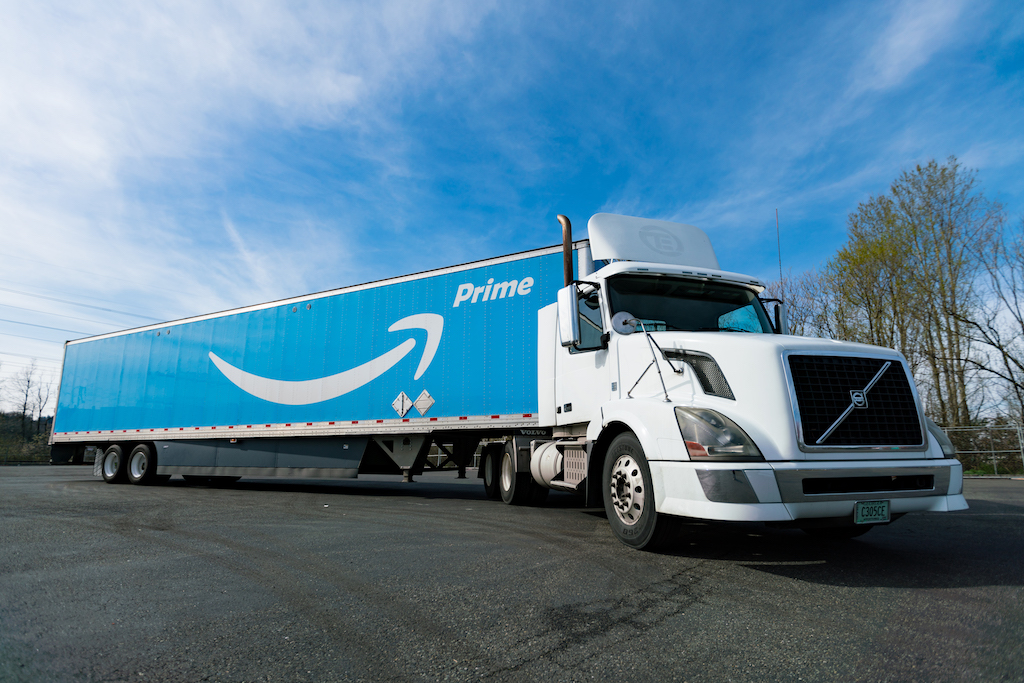
Amazon
This coming Monday, June 16, marks a big day for online shopping: Prime Day. Now a major retail event on the order of Black Friday and Cyber Monday, Amazon’s 30-hour sale has become an annual feeding frenzy, with Americans everywhere taking advantage of the deep discounts and free two-day shipping available to Prime members. And yet little thought is given to the workhorses who make it all possible: truck drivers. Someone’s got to move all those packages.
It’s not exactly surprising that Prime Day has the potential to be a major windfall for trucking companies, which help ferry packages between warehouses and distribution centers. Some in the industry have started calling the event “Christmas in July.” What is surprising is that, as ecommerce grows and there’s more need for truck drivers than ever, fewer and fewer people are willing to do the work.
Last Christmas, freight volumes soared to near-record levels, with the country’s highest retail sales in years. That same economic boom that’s putting more dollars in shoppers’ wallets is also leading to record-low unemployment. As a result, fewer Americans are deciding to take up a specific kind of unglamorous, low-skilled, decently paying work: truck driving. That rejection is exacerbating what analysts have been calling a years-long shortage, transforming it into full-blown “crisis level.” Last year, the American Trucking Associations (ATA) found that America has a shortage of 51,000 long-haul drivers. This year, it could jump to 63,000.
Maybe it’s because wages have stayed low. Right now, the median wage for a long-haul truck driver is around $53,000. “We’ve forced our carriers to drive their prices down,” a Land O’Lakes supply chain manager said recently, explaining why driver wages haven’t kept up with economic growth. “Trucking companies don’t have many levers. There is fuel—carriers can’t control that. And there are driver wages.” In other words? Wages are where carriers cut costs.
Long-haul truck drivers are the guys—and it usually is a guy—who drive an eighteen-wheeler down the highway, hauling up to 80,000 pounds of cargo on a tractor hitched to a semi-trailer truck. They represent around half of America’s 3.5 million truck drivers. The work is not glamorous. Drivers cobble together routes that put them on the road for weeks or months. They live in small cabins and sleep in a mattress behind their seats. Without regular access to healthy meals, many subsist on junk food. They’re twice as likely to be obese. Like farming, big rig driving isn’t just a job—it’s a lifestyle.
As a vocation, truck driving is beset by small, if consequential, challenges. Long-haul drivers told Bloomberg that a lack of parking can be a problem, forcing them to cross state lines, seeking an overnight rest stop, after delivery in an urban location. Because federal law prohibits commercializing interstate rest stops, those can be hours-long, unpaid drives to Flying J truck stops, where drivers can expect a hot shower, a decent meal, and overnight electricity to keep the air conditioning running inside the cabin.
Photo by Paul Sullivan, graphic by NFE
Indignities and logistical difficulties like these make the work even harder than it looks on paper—and could help explain why long-haul companies are having trouble replacing drivers when they retire. Much has been said about truck driving’s graying workforce. The average age of a long-haul driver is around 49 years old, while those who run local routes for private carriers are even older, at 52. Truck drivers are America’s oldest male workforce.
According to ATA, rather than bringing in new drivers to replenish the pool, trucking companies plan on poaching drivers from other carriers, offering sign-on bonuses of $1,500 or higher pay. The churn is constant. For-hire truckers turn over at an 80 percent rate—though the rate is much lower in private fleets, where companies like Pepsi can offer a median pay of around $86,000, along with stable scheduling, and regional routes that allow drivers to come home at the end of the day.
If the shortage grows, disruptions could follow: higher costs for inventory, shipping delays, understocked stores. Online shopping may seem frictionless—to use a Silicon Valley buzzword—but the real-world infrastructure that supports it is cracking under the strain. In January, delivery loads were outpacing available big rigs by fifteen to one, with shipping companies like Michelin either postponing deliveries or paying extra to “jump to the front of the line.” And as drivers become more scarce, the cost of carrying cargo rises.
To wit: In February, Tyson Foods said it would raise prices to offset $200 million in new freight costs. In March, General Mills announced it would raise prices on meals and snacks, and sell some products in smaller packages. The chief executive blamed an “unprecedented,” 20-year high in shipping costs. Then, in April, Amazon raised the price of Prime memberships, which offer free two-day shipping, by 20 percent.
Can America’s love affair with two-day shipping continue when drivers are in such short supply?
Retailers who run with minimal back stock can find themselves with empty shelves when their overburdened, stretched-out truck fleets are late to deliver. Indeed, in February, the CEO of Lowe’s Market said the trucking shortage was causing problems in stocking his warehouse. But whether you and I will notice sold-out stores or sky high prices is unclear.
Why wouldn’t the bill pass? Because driving an 18-wheeler is one of the most dangerous jobs in America. Being a commercial driver is nearly eight times as deadly as joining law enforcement, according to the Bureau of Labor Statistics. Putting more teenagers behind the wheel can’t help—despite a much-criticized regulation that went into effect last year, equipping trucks with electronic logging devices. The safety measure, which is designed to limit the hours in a day for drivers, has led some to complain about diminished earnings.
In some way, the bill points to a future of truck driving as an even more transient, even less stable and predictable, line of work. Imagine the much-ballyhooed future of autonomous vehicles, where a younger truck operator is a passenger in his truck.
“Autonomous has been a big subject of media interest,” Kara Deniz, the Teamsters press secretary, told The New Food Economy. The union represents 30,000 long haul drivers, and 300,000 truck drivers overall. “Well, then it’s difficult to recruit. If you’re trying to threaten the viability of the truck driver in the cab, then how do you expect them [recruits] to sign onto something longer-term?”
Getting rid of the labor altogether—the ultimate fix.











